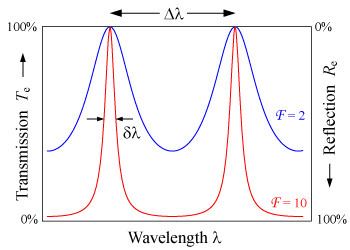 | ||
Free spectral range (FSR) is the spacing in optical frequency or wavelength between two successive reflected or transmitted optical intensity maxima or minima of an interferometer or diffractive optical element.
Contents
The FSR is not always represented by
In general
The free spectral range (FSR) of a cavity in general is given by
where
In wavelength, the FSR is given by
where
Diffraction gratings
The free spectral range of a diffraction grating is the largest wavelength range for a given order that does not overlap the same range in an adjacent order. If the (m + 1)-th order of
Fabry–Pérot interferometer
In a Fabry–Pérot interferometer or etalon, the wavelength separation between adjacent transmission peaks is called the free spectral range of the etalon and is given by
where λ0 is the central wavelength of the nearest transmission peak, n is the index of refraction of the cavity medium,
The FSR is related to the full-width half-maximum δλ of any one transmission band by a quantity known as the finesse:
where
This is commonly approximated (for R > 0.5) by
